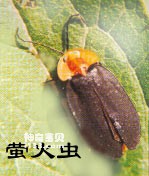At dusk in summer, among the grass and shrubs in mountain streams, it is common to see small lanterns hanging in the air, as if competing with the stars, or like a couple holding lanterns for a night out. If you use a small net to cover the "little lamp", you will see that it is a small beetle with a hard shell. Because the end of its abdomen can emit a little bit of fluorescence, people gave it a vivid name - firefly.

Fireflies belong to the order Coleoptera and the family Lucidae in the insect family. There are about 2,100 species of their distant relatives or close relatives known in the world, and 76 species have been recorded in my country. Generally, the body length of fireflies is several millimeters, and the largest ones are more than 17 millimeters long. Fireflies are magical and beautiful insects. The slender and slightly flat body has a blue-green luster, and the front and back are flat and wide, often covering the head. A pair of tentacles with small teeth on the head are divided into 11 segments. Three pairs of slender, crawling feet. The male has well-developed wing elytra, and the hind wings are like fans, usually folded under the forewings and only extended when flying; the female's wings are short or wingless. Some groups are gregarious, but it should be noted that not all species of the firefly family can emit light. The life of a firefly goes through four completely different insect states: egg, larvae, pupa, and adult. It is a complete metamorphosis insect.

Light-emitting mechanism and its applications
The light-emitting organ of the firefly grows on the three terminal segments of the female's abdomen. From the outside, it is just a silver-gray transparent film, which is the fluorescent pigment. If you peel off this film and observe it under a magnifying glass, you can see thousands of luminescent cells, followed by a reflective layer, surrounded by small tracheae and densely packed slender nerve branches. The main substances in luminescent cells are luciferin and luciferase. When fireflies start to move, their breathing speeds up, and a large amount of oxygen is absorbed into the body. The oxygen enters the luminescent cells through the small trachea. When luciferin interacts with the luciferase that acts as a catalyst in the cell, the luciferin will be activated and produce a biological oxidation reaction. , causing the underbelly of the firefly to emit a bright green light. And due to the different breathing rhythms of fireflies, a "flash signal" that is bright and dark is formed. After research, people have formulated a simple formula for its luminous process:
Introduction
Fluorescein + oxygen ─────→ emit fluorescence
The luciferin in fireflies is not inexhaustible, so where does the energy come from when they continue to emit light many times? It turns out that energy comes from adenosine triphosphate (ATP for short), which is the substance that supplies energy in all living things. With this kind of energy in the firefly's body, it can not only shine continuously, but also be brighter. Only the light-emitting structure cannot emit light, and it must be regulated and controlled by the brain nervous system. If you do an experiment and cut off the head of the firefly, the light-emitting mechanism will lose its function. The entire 2nd and 3rd last segment of the female's abdomen can glow, which looks like a broad band, while the distal segments only form spot-like luminescence, which can be seen on both sides of the body segments and can also be seen from the back. Only the distal segment of the male's abdomen can emit light, which is the same as the distal segment of the female's abdomen, also showing two dots of light.

Eggs, larvae, and pupae can all emit light. The eggs cannot emit light when they are first laid, but when they are about to hatch, two light spots can be seen from outside the egg shell. Experiments have shown that it is caused by the activity of larvae inside the egg shell. Therefore, it is actually the formed larvae that emit light. The phosphorus is visible in the penultimate segment of the larvae's abdomen, but it can only emit two light spots. It is visible from the back. 4-5 days after pupation, there is a visible light spot on each side of the end of the pupa's abdomen, but the pupa is in a cocoon made of mud, so its light is not visible.
Fireflies emit light with very high efficiency, converting almost all chemical energy into visible light, which is several to dozens of times more efficient than modern electric light sources. Because the light source comes from chemicals in the body, the light emitted by fireflies is bright but has no heat and does not produce a magnetic field. People call this light "cold light." Since the light of fireflies does not contain radiant heat, physicists believe that it is an ideal light because when things emit light, they also generate heat at the same time, such as a lit candle. Another example is that when a light is turned on, the bulb becomes too hot. However, people do not need lights to generate heat. It would be ideal if we could create light that does not generate heat like fireflies. More than thirty years ago, people simulated the principle of fireflies to create a fluorescent lamp (fluorescent lamp), which basically met this requirement.
With the development of science, the application of fluorescence is becoming more and more widespread. Fluorescence is used to check the bacterial content in food, fluorescent lamps are used to illuminate mines containing explosive gas, indicator lights in ammunition depots, and luminous lights for underwater operations are all made of fluorescent light. Based on the luminescence principle and mechanism of fireflies, American biochemists proposed the principle of electron transfer reaction, which can explain corrosion phenomena, photosynthesis, etc., especially the development and utilization of lasers, and won the 1992 Nobel Prize in Chemistry.
animal tags:
We created this article in conjunction with AI technology, then made sure it was fact-checked and edited by a Animals Top editor.